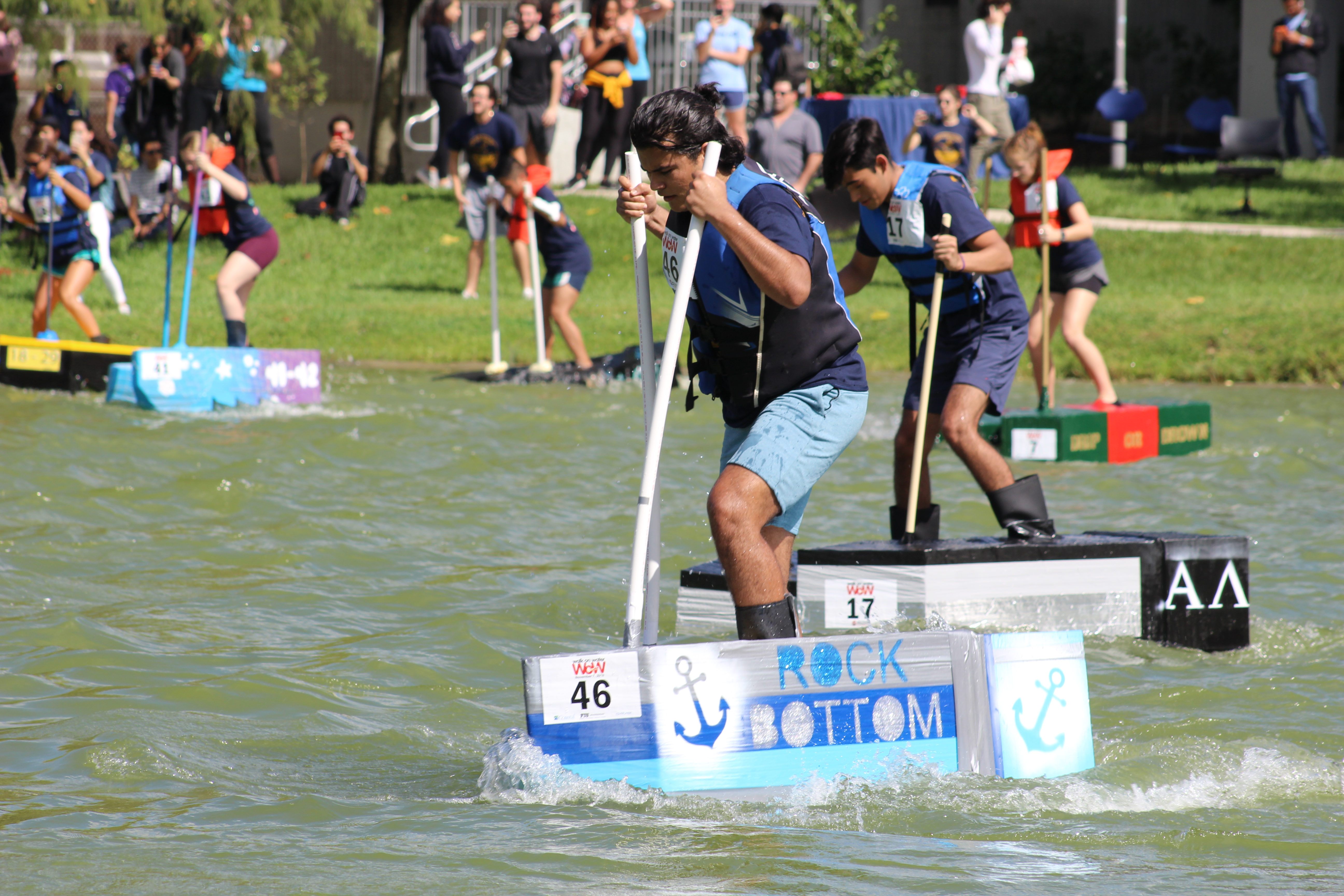Guido Gonzalez/Staff Writer
With a passing grade and a $2,000 cash prize on the line, FIU’s architecture students raced against the clock before racing across a lake for the 30th annual Walk on Water event.
The event was founded and is orchestrated by architecture professor, Jaime Canaves, who has been teaching at FIU for 40 years.
“I like assignments where instead of the student simply giving answers, they have to do something,” said Canaves. “They have to build it and go through the whole experience.”
The event began as an assignment in the fall of 1989 for a materials and methods of construction class Canaves was teaching. The students had to design and construct shoes capable of crossing a large body of water.
The location chosen to test these shoes was the Green Lake located in the heart of the Modesto Maidique Campus, right behind the Steven and Dorothea Green Library.
Unfortunately, the students were not allowed to cross the lake due to insurance problems, so Canaves selected the best designed shoes and crossed the lake himself.

Jaime Canaves, an FIU architecture professor that started the Walk on Water competition 30 years ago, poses next to a wall of previous Walk on Water winners. The photo to the left of him was of him at the first competition. Jesse Fraga/PantherNOW
And so, Walk on Water was born. However, for the following three years, instead of taking place at FIU, Canaves hosted the event in a lake where his house was being constructed nearby.
It was during those three years the event gained recognition from FIU and local media. In 1993, the event was brought back to FIU, where it has been held every year since then.
Starting in Fall 2016, the competition was opened to students from across the country, including the University of Florida and Palm Beach State College, where this year’s champions came from.
Now that the event reached a milestone celebration of 30 years, the students who competed felt the pressure before the race began.

A competitor treads water during the Walk on Water competition. Jesse Fraga/PantherNOW
A lot of factors had to be considered during preparations for the event, namely materials, designs, budgeting and problem-solving skills.
The architecture students taking Canaves’ Materials and Methods of Construction class worked on their designs in the first few weeks of the semester.
Amanda Wojtasiak, a sophomore in Canaves’ class, spent between $50 to $100 in order to purchase materials for the water-shoes.
“We got the block of Styrofoam for free but we had to buy duct tape, broomsticks for the poles in the front and the aluminum for the flaps in the back,” said Wojtasiak.
Even specific glues were needed. One had to be “lock-tight and water resistant” and the other had to be foam-based so it could expand and provide a tight seal in the shoe.
Once the students had all their materials, their next task was to design and test the shoes to make sure they were capable of treading water.

A competitor treads water during the Walk on Water competition. Jesse Fraga/PantherNOW
Alejandro Calzadilla, a sophomore, had to redesign his shoes three times. He tested each design in Green Lake.
“The first design wasn’t getting me anywhere because I had the spikes go the opposite way, so they were taking me backward,” said Calzadilla.
The spikes on the water shoes were used to gain traction against the water.
A pair of good water-walking shoes doesn’t just need to float, but needs to also gain traction in order to move and support the weight of the student wearing them.
The second time Calzadilla redesigned his shoes was because he had cut down them too thin and they broke from the pressure between his weight and the water.
For the third design, Calzadilla kept the soles of his shoes flat, without any spikes and with one new modification: A wooden box in the back of his shoes for propulsion.
“The box catches the water as you go through and then flushes the water out,” said Calzadilla. “It pulls in the water and then as you lift it, it takes it out and that’s what moves you forward.”
A cash prize of $1,000 was awarded to the first place winner, followed by another $1,000 for whoever breaks the record time.
When asked about what they would do with their cash prizes, Calzadilla said, “I’ve been saving up for a new car because I don’t have that kind of money.”
Wojtasiak had a different idea of what she would use her money for.
“Definitely towards school and art supplies,” she said. “Tuition, all of that stuff would come first.”
FIU’s Walk on Water event was held on Nov. 7 from 11:00 am to 12:00 pm in the Green Lake located at the heart of MMC.
The first place was awarded to Team Palm from Palm Beach with a record-breaking time of 57.72 seconds. Members include Arman Alverdian as the pilot, Mauricio Guerro Garcia and Cassandra Yates.

Team Palm from Palm Beach won $2000 with a record-breaking time of 57.72 seconds. Members include Arman Alverdian as the pilot, Mauricio Guerro Garcia and Cassandra Yates.Jesse Fraga/PantherNOW
Second place was awarded to FIU’s Seasoned Veteran, the first team to finish for FIU. The team included Jonathon Chang as the pilot and Tristian Sykes.
Note: This story has been edited for added information.






Be the first to comment on "FIU School of Architecture Celebrates 30 Years of Walking on Water"